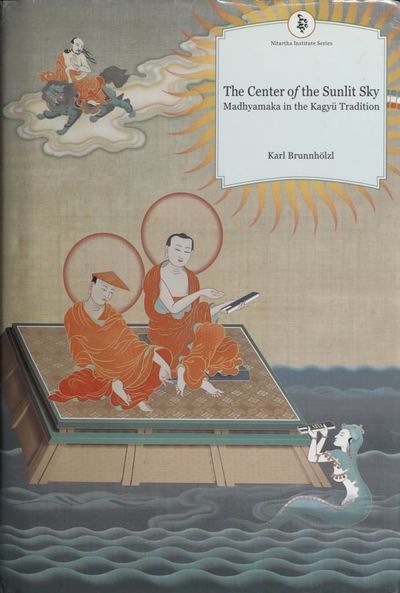- Acknowledgments11
- Foreword 13
- Preface 17
- Introduction 25
- PART ONE: The General Presentation of Madyamaka in the Kagyü Tradition 45
- 1. The Transmission of Madhyamaka from India to Tibet and Its Relation to Vajrayāna and Mahāmudrā 47
- 2 The Middle from Beginning to End 69
- Madyamaka Ground 72
- What Is Reality? 72
- No Ground for the Two Realities 77
- The Detailed Explanation of the Two Realities 80
- The Meaning of the Terms 80
- Painting the Sky: A Description of Their Defining Characteristics 82
- Are the Two Realities One or Different? 88
- Seeming Divisions of the Seeming 94
- Dividing Space: Divisions of the Ultimate 99
- A Critical Analysis of Some Other Tibetan Views on the Two Realities in Centrism101
- The Definite Number of Two Realities and the Purpose of Understanding Them105
- The Emptiness of Emptiness 110
- Freedom Is the Nature of Not Having a Nature 110
- Elaborations on Simplicity 114
- The Twenty Emptinesses117
- The Sixteen Emptinesses122
- The Two Types of Identitylessness 126
- Lost Identity 126
- Phenomenal Identitylessness 135
- Personal Identitylessness 137
- Are the Two Identitylessnesses One or Different? 141
- The Purpose of Teaching Two Identitylessnesses 141
- From Knowledge to Wisdom 142
- Madhyamaka Path153
- How Can Madhyamaka Be a Personal Practice? 157
- Reasoning and Debate in Centrism 172
- Three Stages of Analysis by Nāgārjuna and Aryadeva 172
- Is Reasoning Reasonable? 174
- Reasons and Negations 177
- What Is the Object of Negation in Centrist Reasonings?193
- The Status of Valid Cognition in Centrism 199
- Do Centrists Have a Thesis or Position?218
- Illusory Lions Killing Illusory Elephants: Empty Reasonings for Liberation231
- Some Essential Points of Centrist Reasoning231
- Disillusionment with Phenomenal Identity 235
- The Five Great Madhyamaka Reasonings 235
- Other Reasonings 262
- Unmasking Personal Identity 264
- The Result of Centrist Reasoned Analysis 271
- Madhyamaka Meditation 273
- Why Is Analytical Meditation Necessary? 273
- Calm Abiding and Superior Insight 276
- Analytical Meditation and Resting Meditation 279
- Working with the Mind in Meditation and Daily Life 285
- How to Practice a Session of Analytical Meditation 290
- The Progressive Stages of Meditation on Emptiness 295
- Mental Nonengagement in Meditation 310
- Madhyamaka Conduct 321
- Madhyamaka Fruition 323
- Madyamaka Ground 72
- 3 The Distinction between Autonomists and Consequentialists 333
- Classifications of Centrism in India and Tibet 333
- Refutation of Mistaken Assumptions about Autonomists and Consequentialists 341
- The Actual Distinction between Autonomists and Consequentialists 360
- How the Distinction between Autonomists and Consequentialists by Later Tibetans Is a Novelty 373
- The Origin of the Controversy between Autonomists and
Consequentialists 392 - Do Hearers and Solitary Realizers Realize Emptiness? 421
- Conclusion 438
- 4 Is There Such a Thing as Shentong-Madhyamaka? 445
- The Yogācāra System in General457
- The System of the Lineage of Vast Activity 460
- The Treatment of Yogācāra and the Rangtong-Shentong Controversy in
Tibet 500 - The Single Final Intention of the Two Philosophical Systems of the Great Vehicle 515
- 5 The Distinction between Expedient and Definitive Meaning 527
- 6 An Outline of Some Major Differences between Mikyö Dorje's and Tsongkhapa's Interpretations of Centrism 553
- PART TWO: The Bodhicaryāvatāra and Pawo Tsugla Trengwa 599
- 7 Some Remarks on the Bodhicaryāvatāra and Pawo Rinpoche's Commentary601
- 8 The Ninth Chapter of Pawo Rinpoche's Commentary on The Entrance to the Bodhisattva's Way of Life 617
- Appendix I: A Short Biography of the Second Pawo Rinpoche Tsugla Trengwa 791
- Appendix II: Non-Buddhist Indian Schools 794
- Appendix III: Tibetan Text of the Ninth Chapter of the Bodhicaryāvatāra800
- Glossary: English–Sanskrit–Tibetan816
- Glossary: Tibetan—Sanskrit—English823
- Bibliography 831
- Endnotes 853
- Index 963
No edit summary |
No edit summary |
||
| Line 75: | Line 75: | ||
** {{i|The Yogācāra System in General|457}} | ** {{i|The Yogācāra System in General|457}} | ||
** {{i|The System of the Lineage of Vast Activity |460}} | ** {{i|The System of the Lineage of Vast Activity |460}} | ||
** {{i|The Treatment of Yogācāra and the Rangtong-Shentong Controversy in Tibet |500}} | ** {{i|The Treatment of Yogācāra and the Rangtong-Shentong Controversy in<br>Tibet |500}} | ||
** {{i|The Single Final Intention of the Two Philosophical Systems of the Great Vehicle |515}} | ** {{i|The Single Final Intention of the Two Philosophical Systems of the Great Vehicle |515}} | ||
* {{i|'''5 The Distinction between Expedient and Definitive Meaning'''| 527}} | * {{i|'''5 The Distinction between Expedient and Definitive Meaning'''| 527}} | ||
Revision as of 15:00, 10 March 2020
Madhyamaka is a potent and universally accessible means of calming out suffering and awakening to our innate wisdom. The Center of the Sunlit Sky artfully rescues this brilliant teaching from its unwarranted reputation for intellectual opacity and reinstates it as a supremely practical toolkit for everyday living. The aim of this book is to take Mahyamaka out of the purely intellectual corner into which it–unjustly–gets boxed. It is an attempt to show how Madhyamaka actually addresses and works with all of our experiences in life.
The book follows the original Indian sources as well as the standard commentaries on Madhyamaka in the Kagyü School of Tibetan Buddhism. At the same time, these materials are adapted for a contemporary audience, combining the familiar sharpness of Madhyamaka reasonings (launching a massive assault on our cherished belief systems) with exploring the practical relevance of the Madhyamaka way of mind training.
Part One of the book, "The General Presentation of Madhyamaka in the Kagyü Tradition," provides an overview of the transmission of Madhyamaka from India to Tibet and its relation to Vajrayāna and Mahāmudrā, followed by a general presentation of Madhyamaka in terms of ground, path, and fruition. Further chapters are devoted to the Autonomist-Consequentialist distinction, the controversial issue of "Shentong-Madhyamaka," the distinction between expedient and definitive meaning, and a penetrating presentation of the major differences between the Eight Karmapa's and Tsongkhapa's interpretations of Madhyamaka.
Part Two consists of a brief introduction to the Bodhicaryāvatāra and a translation of the Second Pawo Rinpoche's commentary on its ninth chapter (on knowledge).
(Source: book jacket)
| Citation | Brunnhölzl, Karl. The Center of the Sunlit Sky: Madhyamaka in the Kagyü Tradition. Including a translation of Pawo Rinpoche's commentary on the knowledge section of Śāntideva's The Entrance to the Bodhisattva’s Way of Life (Bodhicaryāvatāra). Nitartha Institute Series. Ithaca, NY: Snow Lion Publications, 2004. |
|---|---|
- Dpa' bo gtsug lag phreng ba. Byang chub sems dpa'i spyod pa la 'jug pa'i rnam bshad theg chen chos kyi rgya mtsho zab rgyas mtha' yas pa'i snying po. The Essence of the Immeasurable, Profound and Vast Ocean of the Dharma of the Great Vehicle. Rouffignac, France: Nehsang Samten Chöling, n.d. See Sarnath: vajra vidya institute, 2003.

In Buddhism, we do not study in order to follow a curriculum or pursue a career but because we intend to learn how to tame our minds, see things as they are, and gain freedom from suffering.
~ in The Center of the Sunlit Sky, page(s) 26
Since the materials are tailored to address the mind, plenty of emotional and intellectual reactions are sure to be triggered by this process of the mind working with its contents and being worked on by them. All of these reactions can and should be acknowledged, watched, and processed as they appear. This is nothing other than practice–mindfully dealing with our experiences.
~ in The Center of the Sunlit Sky, page(s) 26
From a Buddhist point of view, our human mental world is a highly conceptual one. Pure, immediate experience unaccompanied by conceptual processing hardly ever happens. Since we deal with the world through thoughts and concepts most of the time anyway, we might as well make use of them in an intelligent way on our Buddhist path, rather than regarding our thoughts as something to get rid of and deliberately excluding our intellect from our practice.
~ in The Center of the Sunlit Sky, page(s) 28
A typical Madhyamaka answer to the question "What is Madhyamaka?" would state what it is not: It is not a philosophy, not a religion, not a doctrine, not a historical school of thought, not a belief system, not a linguistic theory or analysis, not a psychotherapy, not agnosticism, not nihilism, not existentialism, nor is it an intellectual mind game of some people in India and Tibet who had too much spare time and just wanted to tease others.
~ in The Center of the Sunlit Sky, page(s) 29
A typical Madhyamaka answer to the question "What is Madhyamaka?" would state what it is not: It is not a philosophy, not a religion, not a doctrine, not a historical school of thought, not a belief system, not a linguistic theory or analysis, not a psychotherapy, not agnosticism, not nihilism, not existentialism, nor is it an intellectual mind game of some people in India and Tibet who had too much spare time and just wanted to tease others.
~ in The Center of the Sunlit Sky, page(s) 29
A typical Madhyamaka answer to the question "What is Madhyamaka?" would state what it is not: It is not a philosophy, not a religion, not a doctrine, not a historical school of thought, not a belief system, not a linguistic theory or analysis, not a psychotherapy, not agnosticism, not nihilism, not existentialism, nor is it an intellectual mind game of some people in India and Tibet who had too much spare time and just wanted to tease others.
~ in The Center of the Sunlit Sky, page(s) 29
The whole point of Madhyamaka is what is called "complete freedom from any extremes." Extremes in the Madhyamaka sense refer not only to polarities or notions that are extreme in a very obvious way, but to any kind of reference point whatsoever. In fact, "extreme' is just another word for reference point.
~ in The Center of the Sunlit Sky, page(s)
In the end, Madhyamaka refers to the actual direct experience of a nonreferential state of mind that is utterly free from all discursiveness obscuring the seeing of mind's true nature.
~ in The Center of the Sunlit Sky, page(s) 36
Yet Buddhahood is in no way a self-sufficient or self-indulgent state, since its wisdom-space radiates the living warmth of infinite and spontaneous compassion. Realizing the nature of one's own mind means seeing the nature of everybody's mind.
~ in The Center of the Sunlit Sky, page(s) 43
The more cleary Buddhas and bodhisattvas experience the shining of the true heart of all beings, the more clearly they realize the suffering of these beings that comes from cloudlike ignorance within the clear sky of their minds. Seeing through the illusory nature of both this ignorance and the ensuing unnecessary suffering, Buddhas and bodhisattvas cannot help doing everything they can to wake up and comfort their fellow beings, just as we would try to wake up people who show all the signs of having a terrible nightmare and soothe them by telling them that it was just a dream.
~ in The Center of the Sunlit Sky, page(s) 43


